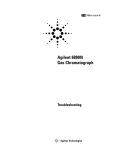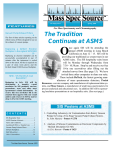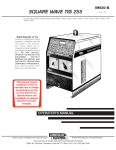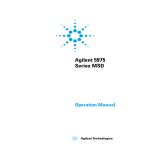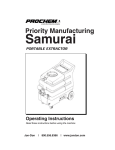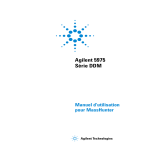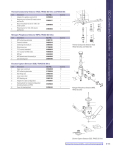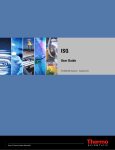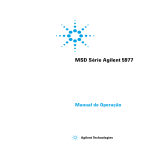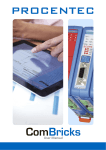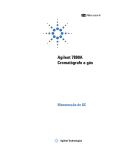Download Agilent G3185B QuickSwap Accessory Reference Manual
Transcript
Agilent G3185B QuickSwap Accessory Reference Manual Agilent Technologies Notices © Agilent Technologies, Inc. 2005 Warranty No part of this manual may be reproduced in any form or by any means (including electronic storage and retrieval or translation into a foreign language) without prior agreement and written consent from Agilent Technologies, Inc. as governed by United States and international copyright laws. The material contained in this document is provided “as is,” and is subject to being changed, without notice, in future editions. Further, to the maximum extent permitted by applicable law, Agilent disclaims all warranties, either express or implied, with regard to this manual and any information contained herein, including but not limited to the implied warranties of merchantability and fitness for a particular purpose. Agilent shall not be liable for errors or for incidental or consequential damages in connection with the furnishing, use, or performance of this document or of any information contained herein. Should Agilent and the user have a separate written agreement with warranty terms covering the material in this document that conflict with these terms, the warranty terms in the separate agreement shall control. Manual Part Number G3185-90101 Edition First edition, October 2005 Printed in USA Agilent Technologies, Inc. 5301 Stevens Creek Boulevard Santa Clara, CA 95052 USA Safety Notices CAUTION A CAUTION notice denotes a hazard. It calls attention to an operating procedure, practice, or the like that, if not correctly performed or adhered to, could result in damage to the product or loss of important data. Do not proceed beyond a CAUTION notice until the indicated conditions are fully understood and met. WA R N I N G A WARNING notice denotes a hazard. It calls attention to an operating procedure, practice, or the like that, if not correctly performed or adhered to, could result in personal injury or death. Do not proceed beyond a WARNING notice until the indicated conditions are fully understood and met. QuickSwap Reference Manual Contents 1 Introduction The Agilent G3185B QuickSwap Accessory GC Requirements 9 New systems 9 Retrofitting existing systems 8 9 Other Important Information 10 Your GC documents 10 Your MSD documents 10 Your MSD ChemStation documents and online help Hydrogen safety information 10 How QuickSwap Works 10 11 Gases 12 Carrier gas 12 Purge gas 12 Calculating Flows 2 13 Operation Overview 16 Limitations and restrictions 16 General recommendations and considerations 17 To Select a QuickSwap Restrictor 18 Total flow rates through the restrictor 19 Column contribution to total flow 20 Recommendations 21 Transfer line temperature 23 QuickSwap Reference Manual 3 To Determine Static Column Output Pressure 26 To Disconnect a Column from QuickSwap 27 If the ferrule sticks in the fitting 28 If the ferrule sticks against the column nut 28 To Connect a Column to QuickSwap To Create a Custom Restrictor 3 30 Backflushing Backflush Advantages 34 Backflush Constraints 34 Considerations and Precautions 36 To Backflush the Column 40 Preliminary calculations 40 To set up the backflush method 4 29 41 QuickSwap Methods Methods 44 Methods provided Sample Method Listing 45 46 To Create a New QuickSwap Method 52 To Convert a Constant Pressure Direct-Connect Method 53 1. Determine the new column head pressure 53 2. Determine the highest flow rate for that column 55 3. Select a restrictor and transfer line temperature 56 4 QuickSwap Reference Manual To Convert a Constant Flow Direct-Connect Method An example 60 Select a restrictor size and temperature 61 Choose a QuickSwap pressure 61 Determine holdup time 61 Run a sample 61 Pressure Pulse Injection Considerations 63 To adjust QuickSwap setpoints for a pressure pulse 5 60 63 Maintenance Inlet Maintenance 68 Removing QuickSwap/Changing the Restrictor Cleaning QuickSwap 70 Troubleshooting 72 Cannot reach QuickSwap pressure setpoint MSD sensitivity too low 73 Peak shape poor 73 Replacement Parts QuickSwap Reference Manual 68 72 75 5 6 QuickSwap Reference Manual Agilent G3185B QuickSwap Accessory Reference Manual 1 Introduction The Agilent G3185B QuickSwap Accessory 8 GC Requirements 9 Other Important Information 10 How QuickSwap Works 11 Gases 12 Calculating Flows 13 Agilent Technologies 7 1 Introduction The Agilent G3185B QuickSwap Accessory The QuickSwap accessory is used with an Agilent gas chromatograph (GC) connected to an Agilent mass selective detector (MSD). QuickSwap provides: • A means for removing or changing columns without the need to cool and vent the MSD. • Protection from entrance of air when doing routine maintenance on columns and inlets. • A means for backflushing columns to remove high-boiling components, reducing run times and cool-down times and minimizing ghosting (chemical noise in the baseline) from run to run. 8 QuickSwap Reference Manual Introduction 1 GC Requirements The QuickSwap accessory mounts at the end of the MSD transfer line inside the GC oven. QuickSwap requires an accurately-regulated inert purge gas supply. Agilent recommends the following configurations. New systems For Agilent 6850 Series II and 6890 GCs: • Option 885—Consists of Option 301, Auxiliary electronic pneumatics control (EPC) plus factory routing of a purge gas line into the GC oven • Accessory G3185B—QuickSwap kit Retrofitting existing systems • Pressure control device. May be Auxiliary EPC accessory (G3349B for 6850 GC, G1570A for 6890 GC) or pneumatics control module (PCM) (G2317A, 6890 only) • Accessory G3185B—QuickSwap kit QuickSwap Reference Manual 9 1 Introduction Other Important Information This document is concerned with the QuickSwap accessory. It describes the operating procedures, routine maintenance procedures, and concepts needed to use the QuickSwap accessory. Installation and checkout steps are contained in the “Installation and Setup” manual, also on this CD-ROM. These two documents contain some, but by no means all, information about the GC and MSD units. We recommend that you consult the following sources for such information. Your GC documents Full descriptions of inlets, the column oven, columns, non-MSD detectors and general operating information. Pay particular attention to hydrogen safety, since this gas is often used as the carrier with capillary columns. Your MSD documents How to operate the MSD part of your system. This is another good source for hydrogen carrier gas safety information, some of which is specific to MSD operation. Your MSD ChemStation documents and online help General operation of a MSD ChemStation system, covering both data acquisition and data reduction. Hydrogen safety information Some MSDs have a separate document on this subject; with others, it is embedded in an operating manual. In either case, review this information periodically to refresh your memory of this very important topic. 5973 MSD Hydrogen Carrier Gas Safety Guide (printed) 5975 MSD 5975 Series MSD Hardware User Information CD-ROM (G3170-9x005, where the “x” represents a number denoting a language version) 10 QuickSwap Reference Manual Introduction 1 How QuickSwap Works QuickSwap is a T-connection placed between the end of the GC column and the entrance to the MSD transfer line. A purge gas flow mixes with column effluent, passes into a deactivated fused silica restrictor inside the transfer line, and then into the MSD source. With a proper choice of restrictor size, column flow, and purge gas pressure, the purge gas blankets the restrictor entrance even when the column is removed. This keeps air out of the MSD and makes it possible to trim or remove columns while the MSD is under vacuum and the transfer line and the restrictor inside of it are still hot, saving pumpdown and equilibration time. QuickSwap requires some changes to direct-connection conditions. Inlet pressure (column head pressure) will be different, transfer line temperature may be different, and the total flow of gas into the MSD will probably be different. It will be necessary to update retention times and response factors and verify any performance metrics prior to analysis of samples. While QuickSwap was designed to minimize performance losses, some losses are possible with specific applications. The guidelines in this manual will help ensure the best possible migration of current methods to QuickSwap methods. Figure 1 shows the plumbing for normal analysis conditions. Purge gas source (EPC, PCM, inlet, manual controller, etc.) Purge flow Restrictor MSD Column QuickSwap Total flow to MSD [Vacuum] Inlet Column flow QuickSwap pressure Total flow to MSD = Purge flow + Column flow Column outlet pressure = QuickSwap pressure = Purge gas source pressure = EPC or PCM pressure Figure 1 Flows and pressures QuickSwap Reference Manual 11 1 Introduction Gases Carrier gas The user selects the appropriate carrier gas based on the availability of an appropriate inert gas and the desired chromatographic properties. Hydrogen and helium are the most common choices for capillary columns. See your GC documentation and other sources for additional carrier gas information. Purge gas The purge gas is usually the same as the carrier gas, with one very important exception. Do not use hydrogen or any other flammable gas as the purge gas, regardless of the carrier gas choice. Quickswap protects the entrance to the MSD when the column is disconnected by blanketing the connection with purge gas. This gas flows into the column oven. Hydrogen or other flammable gas would present a serious fire and explosion hazard if allowed to flow into the oven. WA R N I N G 12 Hydrogen is both a fire and explosion hazard when mixed with air. When the column is detached, purge gas vents into the GC oven. For this reason, hydrogen must not be used as the purge gas. QuickSwap Reference Manual 1 Introduction Calculating Flows Some of the flows in QuickSwap (notably the flow through the restrictor into the MSD) cannot be measured directly; they must be calculated. The CD-ROM supplied with QuickSwap contains two user-contributed utility programs for calculating flows, pressures, and other parameters for capillary columns. The flow calculator, FlowCalc, is simpler; GC Method Translator is somewhat more flexible. Both yield essentially the same results. For operating details, see the help file included with each program. The programs sometimes require absolute pressures (psia) rather than gauge pressures (psig), where psia = psig + 14.696. QuickSwap Reference Manual 13 1 14 Introduction QuickSwap Reference Manual Agilent G3185B QuickSwap Accessory Reference Manual 2 Operation Overview 16 Limitations and restrictions 16 General recommendations and considerations 17 To Select a QuickSwap Restrictor 18 Total flow rates through the restrictor 19 Column contribution to total flow 20 Recommendations 21 Transfer line temperature 23 To Determine Static Column Output Pressure 26 To Disconnect a Column from QuickSwap 27 If the ferrule sticks in the fitting 28 If the ferrule sticks against the column nut 28 To Connect a Column to QuickSwap 29 To Create a Custom Restrictor 30 This chapter discusses the parameters that control QuickSwap and other operating procedures. Backflushing is discussed in a separate chapter. Agilent Technologies 15 2 Operation Overview After installation and setup, using QuickSwap consists of the following tasks: 1 Select and install the appropriate restrictor for the application. See “Select a restrictor size and temperature” on page 61, “To Create a Custom Restrictor” on page 30, and the QuickSwap Installation and Setup manual. 2 Create or modify an MSD ChemStation method to set the QuickSwap pressure, temperature, and other parameters so that the total flow into the MSD is acceptable. See “To Convert a Constant Pressure Direct-Connect Method” on page 53, “To Convert a Constant Flow Direct-Connect Method” on page 60, or “To Create a New QuickSwap Method” on page 52. 3 Analyze the sample. The two QuickSwap setpoint parameters of importance in controlling flow to the MSD are the pressure for its purge gas supply and the transfer line temperature. The pressure is the main parameter used to adjust total flow into the MSD once a specific restrictor is chosen. Limitations and restrictions QuickSwap restrictions and limitations: • Select a restrictor diameter to accommodate a slightly higher flow than the maximum flow exiting the column. This allows the purge gas pressure source to control the QuickSwap pressure, prevents back diffusion of air into lines while in use, and ensures peak shapes are not distorted. • Total flow into the MSD must not exceed the high-vacuum pump capacity. • Hydrogen (or other flammable gases) must never be used as the purge gas. • Current MSD ChemStation software and GC firmware limit column outlet pressure to 4 psig if accurate calculated column flow is desired. Greater pressures can be set but the value presented as Column flow will be incorrect. This is important if you wish to run in constant flow mode. Stay within the software limit to correctly configure your column outlet pressure so that correct pressures are set to generate the desired column flow rate. If running the inlet in constant pressure mode or using a pressure program, do not be concerned about the 4 psig column outlet pressure setpoint limitation in column configuration. Just realize that the displayed column flow value will be incorrect. 16 QuickSwap Reference Manual Operation 2 General recommendations and considerations When selecting a restrictor and setting method parameters, keep the following in mind: • The recommended QuickSwap pressure is 4.0 psig for general use. This pressure ensures that air will be excluded when the column is removed without having to set and then reset the QuickSwap pressure. If using a lower Quickswap pressure due to application requirements, raise the pressure to at least 4 psig before removing the column. • MSD EI performance reaches a maximum somewhere between 1.5 and 2 mL/min total flow and decreases outside that range. • Avoid flows >2 mL/min to a diffusion pump. Pumping performance drops much more quickly with a diffusion pump than with a turbo pump, with an increasing chance of backstreaming pump oil (which can contaminate the MSD). • To exclude air when removing the column, maintain the QuickSwap pressure ≥4.0 psig. • A good general rule is to set the QuickSwap pressure 0.2 to 0.5 psig above the static column output pressure. See “To Determine Static Column Output Pressure” on page 26. • When running in constant flow mode, or for accurate column flow display, set the QuickSwap pressure to ≤4.0 psig and ensure that the Column Outlet pressure is the same value as the QuickSwap setpoint pressure. If you do not care about the calculated flow display or are not running in constant flow mode, you can set higher QuickSwap pressures in the MSD ChemStation, but the column configuration screen will not accept Column Outlet values >4 psig. This difference causes inaccurate column flow display, but does not impact pressure methods. QuickSwap Reference Manual 17 2 Operation To Select a QuickSwap Restrictor Restrictors are precut lengths of deactivated fused silica tubing with swaged ferrules attached. The restrictor size, QuickSwap pressure, and transfer line temperature determine the total flow into the MSD. This flow must satisfy two conditions: • It must be greater than the column flow to allow pressure control, to prevent back diffusion of gas into lines while in use, and to ensure peak shapes are not distorted. • It must not exceed the high-vacuum pump capacity, especially during backflushing (if performed). Always consider using whatever restrictor is currently in the MSD. If the needed flows cannot be achieved with this restrictor at a temperature and QuickSwap pressure appropriate for the application, vent the MSD and install a different restrictor. The recommended default size is 100 µm. This restrictor is useful for a wide range of applications and MSD pump configurations. Select a restrictor that has a little more flow capacity at temperature than needed for the method. Use either the tables below, the GC Method Translator, or FlowCalc utility to estimate the rate of gas flow through the restrictor and into the MSD (total flow) under the method conditions. Remember that the total flow into the MSD should be slightly higher than the highest expected column flow. If using one of the user-contributed utilities: 1 Enter 0.17 m (the restrictor length) as the Column Length. 2 If using GC Method Translator, enter a Film Thickness of 0.001 µm to approximate the uncoated restrictor. 3 Enter a temperature close to the maximum temperature of the oven temperature program. Note: Enter temperature in these utilities as if it were “initial oven temperature.” 4 Enter an outlet pressure of 0 psia (MSD vacuum). 5 Enter the QuickSwap pressure as the Inlet or Head pressure (4 psig is a good starting value). 18 QuickSwap Reference Manual Operation 2 6 Compare the resulting flow rate for the restrictor to the maximum expected column flow rate. The flow capacity of the restrictor should be slightly more than the column flow rate. 7 Try alternate temperatures and pressures to predetermine a reasonable set of values for method setpoints. Table 1 lists some flow ranges at temperature for use in selecting a restrictor. Table 1 Mid-range flows for QuickSwap restrictors at 250 °C and 4 psig QuickSwap pressure Inside diameter, µm Part number Total flow into MSD Recommended for 92 G3185-60061 2 mL/min H2* 1 mL/min He Turbo pump MSDs Diffusion pump MSDs 100 G3185-60062 1.4 mL/min He Turbo pump MSDs Diffusion pump MSDs 110 G3185-60063 2 mL/min He 4 mL/min H2* Turbo pump MSDs Turbo pump MSDs 120 G3185-60064 2.4 mL/min He Turbo pump MSDs * Hydrogen value provided for comparison only. Hydrogen may be used as a carrier gas but never as the purge gas. In practice, an inert purge gas also contributes to the flow. See also: “To Create a New QuickSwap Method” on page 52 “To Convert a Constant Pressure Direct-Connect Method” on page 53 “To Convert a Constant Flow Direct-Connect Method” on page 60 “Pressure Pulse Injection Considerations” on page 63 Total flow rates through the restrictor There can be several total flow rates to the MSD in a QuickSwap method. The operating flow is the total flow to the MSD when acquiring data. This flow rate is related to the pumping capacity of the high-vacuum pump, and is selected to optimize data acquisition. There is an optimum operating flow, corresponding to the optimal MSD source pressure. Since each pump QuickSwap Reference Manual 19 2 Operation (standard turbo, performance turbo, diffusion pump) has a different pumping capacity, there are different operating flow ranges for each. For example, one should not exceed 2 mL/min operating flow with most diffusion pump systems. Exceeding recommended operating flows can decrease MSD performance (for example, detection limits and linear operating range). Refer to the MSD’s documentation for its operating flow limits. The total flow rate can vary from the operating flow during a run, for example during an injection pressure pulse or during backflush. These other rates must not exceed the MSD’s maximum allowable flow, which is much higher than the operating flow and is limited by the pumping capacity of the specific system being used. Column contribution to total flow Operating flow is the sum of column flow plus QuickSwap purge gas. The factors that determine column flow are: • Column dimensions Determine your column inside diameter, film thickness, and length. Enter these values in the column configuration screens. • Carrier gas type Enter this choice in the correct configuration screen. • Flow mode or pressure mode Make this choice in the Column screen. • Oven temperature Set this value in the Oven screen. • Pressure pulse, if used Enter this in the Inlets screen. There are two general modes of column flow control: constant pressure mode and constant flow mode (programmed pressure or flow modes are not discussed here). To select the correct restrictor for your application, determine the maximum flow that will come from the column. • In constant flow mode, column head pressure is automatically adjusted during the oven temperature program to maintain a constant column outlet flow, independently of oven temperature, so the maximum column flow rate is the constant flow value. • In constant pressure mode, column head pressure remains constant during the oven temperature program, so column outlet flow changes during the run. Maximum column flow in constant pressure mode occurs at the lowest oven temperature (usually at the start of a run). • If a pressure-pulse injection is used, the pulse pressure is the one that matters. 20 QuickSwap Reference Manual Operation CAUTION 2 During pressure pulse injections, column flow increases. See “Pressure Pulse Injection Considerations” on page 63. Recommendations Use Tables 2 and 3 below as a guide for most GC/MSD applications with 250-µm id columns. The tables show parameter sets that produce the recommended operating flow into the MSD for diffusion (1.5 mL/min) and turbo (2 mL/min) pump systems. If your maximum column flow rate is greater than 1.3 mL/min (1.5–0.2) for a diffusion pump system or 1.7 mL/min (2–0.3) for a turbo pump system, then you should choose a different restrictor and/or adjust QuickSwap pressure or temperature to accommodate the higher flow. CAUTION The conditions in the next two tables show the maximum total flows into the MSD. They correspond to flows for optimal performance. Table 2 Recommendation for diffusion pump. Conditions to yield 1.5 mL/min total flow into MSD Restrictor id, µm Transfer line temperature, °C Carrier gas QuickSwap pressure, psig (He) 110 250 Helium 1 100 227 Helium 4 92 150 Helium 4 92 150 Hydrogen 1 QuickSwap Reference Manual 21 2 Operation Table 3 Turbo pumps. Conditions to yield 2 mL/min total flow into MSD Restrictor id, µm Transfer line temperature, °C Carrier gas QuickSwap pressure, psig (He) 110 250 Helium 4 100 150 Helium 4 92 250 Hydrogen 4 Other operating flows While Tables 2 and 3 show reasonable setpoints for MSD operation, higher flows can be used. For example, a diffusion pump can be used effectively up to 2 mL/min, the standard turbo pump up to 2.5 mL/min, and the performance turbo pump up to 4 mL/min. At the higher flow rates, MSD performance will decrease but it will often still meet the needs of high-flow methods. If the desired total flow into the MSD is not shown in table 2 or 3, use the user-contributed FlowCalc or GC Method Translator programs to find a suitable combination of restrictor id, QuickSwap pressure, and temperature. When using these programs, treat the restrictor as if it were a column and input restrictor temperature as if it were initial oven temperature. The restrictor length is 0.17 m (17 cm). Restrictors have no stationary phase, although they are deactivated. See also “Transfer line temperature” on page 23. Maximum flow rates Always make sure that the total flow to the MSD does not exceed the maximum allowable flow for the system. See “Backflushing” on page 33 and the MSD’s documentation. 22 QuickSwap Reference Manual Operation 2 Transfer line temperature The MSD transfer line temperature (in the MSD ChemStation, usually Aux 2 for 6890 GCs or the detector temperature for 6850 GCs) controls the restrictor temperature. Use the transfer line temperature in conjunction with the QuickSwap pressure to set the total flow into the MSD. Increasing temperature reduces the flow through the restrictor at a given QuickSwap pressure. The GC Method Translator program, FlowCalc program, and Tables 2 and 3 may be used to determine transfer line temperature for a desired total flow to the MSD. Restrictors are deactivated and have no stationary phase. They are short (17 cm) and exhaust into a vacuum (the MSD chamber). Thus the linear velocity is very high and there is virtually no retention in the restrictor. This allows the restrictor temperature to be as much as 150 °C lower than the maximum column temperature without affecting retention time, peak area or height, or peak shape. Temperatures greater than the maximum column temperature should be chosen with care due to possible increase in thermal degradation of the solutes. Figures 2, 3 and 4 show purge gas flow versus temperature at different pressures. QuickSwap Reference Manual 23 2 Operation 4 120 µm Flow to MSD (mL/min Std) 3.5 3 110 µm 2.5 2 100 µm 1.5 1 92 µm 0.5 0 100 150 200 250 300 350 400 Transfer line temperature (˚C) Figure 2 Total flow to MSD: Carrier gas = helium; purge gas = helium at 1 psig 5.5 Flow to MSD (mL/min Std) 5 120 µm 4.5 4 3.5 110 µm 3 2.5 100 µm 2 1.5 1 0.5 100 92 µm 150 200 250 300 350 400 Transfer line temperature (˚C) Figure 3 24 Total flow to MSD: Carrier gas = helium; purge gas = helium at 4 psig QuickSwap Reference Manual Operation 2 Flow to MSD (mL/min Std) 8.5 7.5 110 µm 6.5 5.5 100 µm 4.5 3.5 2.5 92 µm 1.5 0.5 100 150 200 250 300 350 400 Transfer line temperature (˚C) Figure 4 QuickSwap Reference Manual Maximum total flow to MSD when using H2 carrier gas with helium purge gas. Actual total flow to MSD will be slightly less than that shown in the curves. Carrier gas = hydrogen; purge gas = helium at 4 psig 25 2 Operation To Determine Static Column Output Pressure Check the static column output pressure to ensure that the choice of restrictor, temperature and QuickSwap pressure can accommodate the maximum column flow rate. This is especially important when using H2 carrier gas and He makeup, because the static pressure will be higher than if pure H2 were flowing through the restrictor. A straightforward way of measuring QuickSwap static pressure is to observe QuickSwap pressure while the column is at the method's maximum flow rate. For pulsed pressure injection methods, check under the pulse conditions. NOTE If using a PCM for QuickSwap pressure control, select the Inlets icon to set the pressure in step 5b below. 1 Make sure that the GC and MSD are on and temperatures and pressures are stable. 2 If the method calls for pulsed splitless injection, press Prep Run or set inlet pressure equal to pulse pressure manually before proceeding. 3 Confirm that the column is at the initial temperature. 4 Confirm that the column inlet pressure is correct (maximum of method or pulse pressure). 5 Turn off the QuickSwap purge gas pressure (Aux EPC #5, not Aux #2 which controls the transfer line temperature). a On the Instrument Control screen, select Instrument, then GC Edit Parameters. b Click the Aux icon. Select Aux Channel Pres Aux #5. c Clear the On checkbox. d Select Apply. 6 Observe the pressure reading when that setpoint becomes stable. This is the static column output pressure and corresponds to the pressure generated at QuickSwap due to the column flow. This pressure should be less than the QuickSwap pressure setpoint if proper conditions are chosen. 26 QuickSwap Reference Manual Operation 2 To Disconnect a Column from QuickSwap A column can be disconnected from QuickSwap while the MSD is pumped down and the transfer line is hot as long as QuickSwap pressure is ≥4 psig. Higher QuickSwap pressures ensure smaller transient air spikes upon column removal or insertion. Materials needed Gloves, clean • Large (8650-0030) • Small (8650-0029) Wrenches Paper clip or similar Procedure WA R N I N G QuickSwap and parts connected to it may be hot. Wear gloves for protection. CAUTION Always wear clean gloves when handling the column, QuickSwap, and connected fittings. 1 Ensure that the QuickSwap pressure (purge gas supply) is ≥4 psig. 2 Remove the column nut. 3 Pull the column out of the fitting. QuickSwap Reference Manual 27 2 Operation If the ferrule sticks in the fitting Occasionally a column will not come out of the QuickSwap fitting because the ferrule is stuck. Do not try to force it! There is a small access hole in the side of the QuickSwap fitting. Insert the end of a straightened paper clip (or similar-sized straight tool) into this hole. Push gently to release the ferrule. If the ferrule sticks against the column nut This is a rare situation. After the nut and ferrule are disconnected from QuickSwap, the two parts can usually be separated by grasping the flat portion at the back of the ferrule with small needle-nose pliers and rocking the ferrule. CAUTION 28 Be careful not to damage or distort the ferrule or break the column protruding from it or you will have to remake the fitting. QuickSwap Reference Manual Operation 2 To Connect a Column to QuickSwap Refer to the instructions found in the “Installation and Setup” manual. QuickSwap Reference Manual 29 2 Operation To Create a Custom Restrictor In some cases, the readily-available Agilent-supplied restrictors do not provide the correct flows for an application. If a method requires a different restrictor, create a custom one as described below. Materials needed Gloves, clean • Large (8650-0030) • Small (8650-0029) Wrenches Column cutting wafer Column-install tool (G1099-20030) Procedure WA R N I N G Wear eye protection for this procedure. CAUTION Always wear clean gloves when handling the column, QuickSwap, and connected fittings. 1 Unwind a length of uncoated deactivated fused silica (UDFS) tubing of the desired id. 2 Slide the swaging nut (G2855-20555), a SilTite ferule of appropriate size (see Table 9 on page 75), and the column-install tool onto the UDFS as shown in Figure 5. Be sure to orient the ferrule as shown, with the narrow end facing the swaging nut. 30 QuickSwap Reference Manual Operation SilTite ferrule 2 Swaging nut Column-install tool UDFS Figure 5 Creating a custom restrictor 3 Thread the swaging nut onto the column-install tool, then use two wrenches to tighten the them together a little at a time, until the UDFS is gripped by the ferrule. When the ferrule just begins to grip, notice the position of the nut and then tighten by turning no more than 15 degrees. 4 Cut off the excess UDFS from the end of the column-install tool. Rest the ceramic column cutter at a 45-degree angle on the end of the column-install tool. Score the UDFS, then break off the end. It should break off with a small length extending beyond the tool. (For more details, see “Prepare the QuickSwap End of the Column” in the QuickSwap Installation and Startup guide.) 5 Loosen the swaging nut from the column-install tool, slide it away from the swaged ferrule, then cut the UDFS at the ferrule. Again, a small portion of UDFS should protrude beyond the ferrule. Remember the restrictor is exposed to high vacuum. Keep it stored in a labeled container and protect it from contamination. QuickSwap Reference Manual 31 2 32 Operation QuickSwap Reference Manual Agilent G3185B QuickSwap Accessory Reference Manual 3 Backflushing Backflush Advantages 34 Backflush Constraints 34 Considerations and Precautions 36 To Backflush the Column 40 Preliminary calculations 40 To set up the backflush method 41 This chapter discusses backflushing, a technique that can shorten analysis time, increase ion source lifetime, and reduce fouling of the MSD by high-boiling sample components. Backflushing is not unique to QuickSwap, but is made much easier by the presence of the pressure-regulated purge gas. Agilent Technologies 33 3 Backflushing Backflush Advantages Backflush is a means of discarding high-boilers from a column after the peaks of interest have eluted. It saves analysis time and has these additional benefits: • Longer column life • less high temperature exposure • removal of high-boilers • protection from air and water at high temperatures • Less chemical background • ghost peaks • “wrap-around” of late eluters from previous runs • stationary phase decomposition peaks • Less contamination of the MSD source • longer time between source cleanings • higher stability of calibrations Backflush Constraints • Backflush cannot be done with constant flow mode methods. • Backflush is restricted to turbo pump systems only. • Care must be taken when setting backflush conditions to make sure that the maximum allowable total flow rate is not exceeded. • It is highly recommended that a pressure gauge be used when setting up backflush conditions. 34 QuickSwap Reference Manual Backflushing 3 Figure 6 shows an example analysis that could benefit from backflushing. Abundance 4.67 n-C23 2.85 2800000 4.12 2400000 3.73 4.49 4.84 5.16 5.48 3.32 2000000 5.79 6.10 1600000 6.73 1200000 800000 7.36 2.27 n-C44 400000 0 7.99 2.50 3.00 3.50 4.00 4.50 5.00 5.50 6.00 6.50 7.00 7.50 8.00 8.50 Time 265 °C Figure 6 QuickSwap Reference Manual 375 ° Analysis without backflushing. Shaded area contains the unwanted high-boilers 35 3 Backflushing Considerations and Precautions CAUTION Data acquisition must be turned off when backflushing. During backflush, a high flow of gas enters the MSD source. The MSD should not be acquiring data under high source pressure (high flow) conditions. This can lead to premature failure of the detector and/or quadrupole. CAUTION Backflushing should only be done with a split/splitless or PTV inlet. Both inlets have vent paths (the split line) and a chemical trap as part of their designs. Attempts to backflush with cool on-column or packed column inlets will most likely damage the pneumatics (EPC, septum purge flow regulator, etc.). CAUTION Due to insufficient pumping capacity, diffusion pumps are not able to handle flows typical of backflush conditions. In addition, abrupt changes in pressure can lead to “backstreaming” and contamination of the mass analyzer with pump oil. Therefore, backflush conditions are restricted to turbo pump systems only. Backflush conditions cause a high flow rate of gas into the MSD. For this reason, care must be taken to avoid conditions that could damage the MSD or cause premature failure of parts. Limitations and considerations for safe and effective performance of backflush with QuickSwap are presented here. Due to the possibility of causing a detrimental electrical discharge in the MSD analyzer, these constraints must be imposed: • Never attempt to acquire data under backflush conditions. Ensure that the analyzer is OFF (not acquiring data) before the onset of backflush conditions and remains OFF for the full duration of the backflush. • Never establish backflush conditions that generate analyzer pressures greater than 1 mtorr (1 × 10-3 torr). Setting up and troubleshooting of backflush conditions requires use of a vacuum gauge. Table 4 shows backflush pumping limits of several MSD systems. These limits are meant to serve as guidelines and are deemed to be typical flow rates under which analyzer pressure would not exceed 1 mtorr. The performance turbos have a distinct advantage over standard turbos when backflushing. 36 QuickSwap Reference Manual Backflushing Table 4 3 Pumping limits (while not acquiring data) Pump type Maximum flow, mL/min Comment Diffusion pump 5 Insufficient, backflush not allowed Standard turbo pump 25 Longer backflush time required Performance turbo pump 100 Best choice, shortest backflush duration Table 5 contains the setpoints used in these examples. Table 5 Example conditions Column 30 m × 250 µm × 0.25 µm Column temperature 250 °C Carrier and purge gas Helium Inlet pressure 0.5 psig during backflush QuickSwap pressure See Table 6 Backflush time Equivalent to 1 to 2 × holdup time Transfer line (restrictor) temperature 250 °C QuickSwap Reference Manual 37 3 Backflushing Table 6 shows the relationship of backflush times and flow rates to the MSD as a function of restrictor choice. Table 6 Backflush conditions QuickSwap pressure, Backflush time, Flow into MSD (mL/min) for restrictor id psig min 92 100 110 120 10 3.5 to 7 1.7 2.4 3.5 5 25 1.4 to 2.8 4.5 6.3 9.3 13 40 0.9 to 1.8 8.5 12 17 25 50 0.75 to 1.5 12 16 24 34 60 0.63 to 1.3 16 22 32 46 75 0.5 to 1.0 23 32 47 66 100 0.4 to 0.8 37 52 77 108 Conditions in the shaded section are suitable for both standard and performance turbos. The higher flow rate examples are suitable only for performance turbo systems. The higher the QuickSwap pressure, the sooner backflush is completed. The range of backflush times reflect 1 to 2 column holdup times. One column holdup time might be sufficient to remove all late eluters, but using two provides some additional assurance. Use the calculator tools provided on the User Information CD to determine flow rates specific to your application. Some concepts to keep in mind while defining appropriate backflush conditions for your application: • Shorter columns require much less backflush time at the same QuickSwap pressure. For example, a 15 m × 250-µm column (half the length of that assumed in Table 6) would require only 0.186 to 0.372 min to backflush with a 50 psig QuickSwap pressure, all else being equal. This is significantly less than half that of the 30-m column because not only is the length shorter, but the flow rate through the 15-m column is much faster than that of the 30-m column with the same head pressure. So, in this example, a column of ½ the length requires only ¼ the time to backflush under the same conditions. • Always check to ensure that the backflush conditions chosen do not generate more than 1 mtorr pressure in the MSD. 38 QuickSwap Reference Manual 3 Backflushing • Lower transfer line (restrictor) temperature increases flow to the MSD. • Select the restrictor appropriately relative to the column id. Narrower columns require higher backflush pressures but at the same time generate less column flow during analysis. Keep both in mind when selecting the restrictor, temperature, and QuickSwap pressures during analysis and backflush. • Column hold-up time is a function of oven temperatures. Higher oven temperatures yield longer hold-up times with the same pressure drop, so backflush times will also be longer. Backflush cannot be done with methods run in constant flow mode. Methods potentially benefiting from backflush should be converted to constant pressure methods first. QuickSwap maintains one of the benefits of constant flow methods; it maintains constant total flow to the MSD during the analysis, thereby maintaining constant source conditions. One must give up the chromatographic benefits of constant flow modes in order to benefit from the advantages of backflush. To backflush using a run time program, go to Instrument Control View > Instrument > GC Edit Parameters > Oven in the MSD ChemStation. Make sure that the oven program includes sufficient time for backflushing (typically as a post-run hold). QuickSwap Reference Manual 39 3 Backflushing To Backflush the Column Preliminary calculations These quantities must be known to set up the backflush procedure. Restrictor size and temperature These are chosen based on the analysis requirements, not the backflush. They will be used to determine the total flow to the MSD during backflushing. Column backflush flow rate Use the Flow Calculator or the Method Translator to determine the reversed flow through the column. You will need the column dimensions, the inlet pressure (we suggest 0.5 psig), and the QuickSwap pressure during backflush. Column backflush holdup time Either calculator will provide this. Minimum backflush time This is the time required to backflush all the high-boiling material off the column to the split vent. The equations include an extra 0.2 min for pressure equilibration. The results are minimum backflush times; you may wish to add more time to be certain that the column is clean. Isothermal If the oven is in an isothermal period (which may be the end of a temperature program) when backflush begins, calculate the minimum backflush time X from: X = 1.5 × Column backflush holdup time + 0.2 min Programmed If the oven is in a temperature ramp when backflush begins, calculate the minimum backflush time X from: X = Column backflush holdup time + 0.2 min 40 QuickSwap Reference Manual 3 Backflushing To set up the backflush method We suggest using run time events for these steps. • Set the Detector to Off just after the last peak of interest returns to baseline. 1 In the MSD ChemStation Instrument Control View, select Instrument > MS SIM/SCAN parameters. 2 Click Timed Events. 3 In the MS Timed Events Table dialog, enter the start time of the backflush, select Detector as the Event Type, select Off as the Parameter, then click Add. 4 Click OK. • Program these actions just after the last peak of interest returns to baseline: • Set the inlet pressure to a low value (we suggest 0.5 psig). • Set the QuickSwap pressure to a high value, determined using FlowCalc or GC Method Translator. • Ensure that the split-vent flow setpoint is at least 25 mL/min and at least 50% more than the Column backflush flow rate. For splitless injection, split flow = purge flow, and purge On time should be before backflush begins. • Set the oven program so that total run time ends after the minimum backflush time (plus any time you may have added) has elapsed. Note that the starting conditions automatically load at the end of the run so that column flow resumes in the forward direction. Figure 7 shows the results of backflushing at approximately 4.5 min. Acquisition stops and late eluting compounds are removed with reversed column flow to the inlet. QuickSwap Reference Manual 41 3 Backflushing 2.85 Abundance 2800000 4.49 2400000 4.12 3.73 3.32 2000000 1600000 Initiation of backflush 1200000 800000 2.27 400000 Time--> Figure 7 42 MSD spectral acquisition OFF 0 2.50 3.00 3.50 4.00 4.50 5.00 5.50 Results of backflush QuickSwap Reference Manual Agilent G3185B QuickSwap Accessory Reference Manual 4 QuickSwap Methods Methods 44 Sample Method Listing 46 To Create a New QuickSwap Method 52 To Convert a Constant Pressure Direct-Connect Method 53 To Convert a Constant Flow Direct-Connect Method 60 Pressure Pulse Injection Considerations 63 This chapter describes: • The QuickSwap-modified checkout methods that are contained on the User CD • How to create or modify an existing direct-connect method to work with QuickSwap. Agilent Technologies 43 4 QuickSwap Methods Methods As stated in Chapter 1, “Introduction,” using QuickSwap requires some changes to existing direct-connection methods, and special considerations when creating a new method. As Figure 1 on page 11 shows, a QuickSwap method must also accommodate the additional setpoint for the purge gas, and ensure appropriate flow into the MSD given that the column exhausts into a positive pressure environment rather than directly into vacuum. To help method developers, several checkout methods are supplied on the User CD. They are derived from the MSD checkout methods and provide reasonable starting points for different flow control modes, ionization modes, and injection modes. Methods are supplied as: • eMethods (.emeth)—For MSD ChemStation versions D.02.00 and higher. eMethods contain control parameters, tune parameters, and explanatory comments. Use .emeth methods if possible. • Methods (.m)—For MSD ChemStation version D.01.xx. Methods contain the control parameters only and are in a different format. • Listings (.pdf)—Printable files derived from the eMethods. Value can be manually input into any MSD ChemStation. 44 QuickSwap Reference Manual QuickSwap Methods 4 Methods provided Table 7 lists the methods provided on the user CD. Table 7 Methods provided Method name Description Ionization mode Column mode Pressure pulse BENZ_PCI_QS_100_CF Benzophenone checkout Positive CI Constant flow No BENZ_PCI_QS_100_CF_PP Benzophenone checkout Positive CI Constant flow Yes OFN_EI_QS_100_CF Octafluoronaphthalene (OFN) checkout Electron impact Constant flow No OFN_EI_QS_100_CF_PP OFN checkout Electron impact Constant flow Yes OFN_EI_QS_100_CP OFN checkout Electron impact Constant pressure No OFN_EI_QS_100_CP_PP OFN checkout Electron impact Constant pressure Yes OFN_NCI_QS_100_CF OFN checkout Negative CI Constant flow No OFN_NCI_QS_100_CF_PP OFN checkout Negative CI Constant flow Yes PFHT_QS PFHT checkout High mass checkout method QuickSwap Reference Manual 45 4 QuickSwap Methods Sample Method Listing The following is a listing of the OFN_EI_QS_100_CF.pdf file. It has been reformatted to fit this page. Welcome to OFN_EI_QS_100_CF.M This method was developed to provide a starting point for QuickSwap use. This method represents a reasonable starting point for a Constant Flow Mode splitless injection method with QuickSwap and the standard MSD checkout column. The method is based on the default EI checkout method. Total flow to the MSD is approximately 1.5 mL/min during the run. Below is a list of method attributes: QuickSwap Restrictor 100 µm id Purge Gas Helium Aux 5 QuickSwap purge gas supply Aux 5 (QuickSwap) Pressure 4 psig during the run (this is also the column "outlet pressure") Aux 2 (transfer line, restrictor) temp 225 °C Flow to MSD Constant at approximately 1.5 mL/min Gas chromatograph info: Column 46 19091S-433(30 m × 250 µm × 0.25 µm HP-5MS) Carrier gas type Helium Sample 1 µL splitless of 1 pg/µL OFN in iso-C8 Inlet Type split/splitless (front) Inlet Liner single taper splitless w/o wool Syringe size 10 µL Injection mode splitless Oven Temp 45 °C (1.25 min) → 250 °C @ 40 °C/min QuickSwap Reference Manual QuickSwap Methods 4 MSD info: Type of tune used: atune.u acquisition scan (50 to 300 µ) samples 2^3 As with setting up all QuickSwap methods, refer to the QuickSwap User Manual for related information and explanation, especially in the sections describing leak checking and pressure settings. Copyright 2005 Agilent Technologies INSTRUMENT CONTROL PARAMETERS: 6890-5973 C:\MSDCHEM\1\METHODS\QUICKSWAP\OFN_EI_QS_100_CF.M Control Information Sample Inlet GC Injection Source GC/ALS Injection Location ALS Use MS Yes ===================================================================== 6890 GC METHOD ===================================================================== OVEN Initial temp: 45 °C (On) Maximum temp: 400 °C Initial time: 1.25 min Equilibration time: 0.25 min Ramps: # Rate Final temp Final time 1 40.00 2 250 0.00 0.0(Off) Post temp: 70 °C Post time: 0.00 min Run time: 6.38 min QuickSwap Reference Manual 47 4 QuickSwap Methods FRONT INLET (SPLIT/SPLITLESS) Mode: Splitless Initial temp: 250 °C (On) Pressure: 15.85 psi (On) Purge flow: 50.0 mL/min Purge time: 1.00 min Total flow: 54.1 mL/min Gas saver: Off Gas type: Helium COLUMN 1 Capillary Column Model Number: Agilent 19091S-433 HP-5MS 5% Phenyl Methyl Siloxane Max temperature: 325 °C Nominal length: 30.0 m Nominal diameter: 250.00 µm Nominal film thickness: 0.25 µm Mode: constant flow Initial flow: 1.2 mL/min Nominal init pressure: 15.85 psi Average velocity: 26 cm/sec Inlet: Front Inlet Outlet: MSD Outlet pressure: 4.00 psi THERMAL AUX 2 Use: MSD Transfer Line Heater AUX PRESSURE 3 Description: Not used Description: Transfer Line Initial temp: 225 °C (On) Initial time: 0.00 min # Rate Final temp Final time 1 48 0.0(Off) QuickSwap Reference Manual QuickSwap Methods AUX PRESSURE 4 Description: Not used 4 AUX PRESSURE 5 Description: QuickSwap Gas Type: Helium Initial pressure: 4.00 psi (On) Initial time: 0.00 min # Rate Final pres Final time 1 0.0(Off) POST RUN Post Time: 0.00 min GC Injector Front Injector: Sample Washes 0 Sample Pumps 3 Injection Volume 1.00 microliters Syringe Size 10.0 microliters PreInj Solvent A Washes 0 PreInj Solvent B Washes 0 PostInj Solvent A Washes 3 PostInj Solvent B Washes 0 Viscosity Delay 0 seconds Plunger Speed Fast PreInjection Dwell 0.00 min PostInjection Dwell 0.00 min MS ACQUISITION PARAMETERS General Information Tune File : atune.u Acquistion Mode : Scan MS Information QuickSwap Reference Manual 49 4 QuickSwap Methods Solvent Delay : 3.75 min EM Absolute : False EM Offset :0 Resulting EM Voltage : 1670.6 [Scan Parameters] Low Mass : 50.0 High Mass : 300.0 Threshold :0 Sample # :3 Plot 2 low mass : 271.8 Plot 2 high mass : 272.3 A/D Samples 8 [MSZones] MS Quad : 150 C maximum 200 C MS Source : 230 C maximum 250 C END OF MS ACQUISITION PARAMETERS 50 QuickSwap Reference Manual QuickSwap Methods 4 TUNE PARAMETERS for SN: EMISSION : 34.610 ENERGY : 69.922 REPELLER : 21.579 IONFOCUS : 90.157 ENTRANCE_LE : 24.000 EMVOLTS : 1670.588 AMUGAIN : 2450.000 AMUOFFSET : 133.000 FILAMENT : 1.000 DCPOLARITY : 0.000 ENTLENSOFFS : 17.569 MASSGAIN : 575.000 MASSOFFSET : 11.000 END OF TUNE PARAMETERS END OF INSTRUMENT CONTROL PARAMETERS QuickSwap Reference Manual 51 4 QuickSwap Methods To Create a New QuickSwap Method 1 Find an existing method that is a reasonable match to your needs. This can be: • One of your own methods, preferably with QuickSwap entries • One of the sample methods from the CD, which do contain QuickSwap entries. 2 Make a copy with a new name. 3 Modify the copy to fit your needs. Table 8 contains a variety of parameter sets. You can use these to make initial settings, then refine them as described in the discussions that follow. Table 8 Typical settings Column flow, mL/min Total flow into MSD, mL/min Carrier gas Restrictor id, µm QuickSwap pressure, psig (He) Transfer line temperature, °C ≤1.3 1.5 Helium 92 4 150 ≤1.3 1.5 Helium 110 1 250 ≤1.3 1.5 Hydrogen 92 1 150 ≤1.7 2 Helium 110 4 250 ≤1.7 2 Hydrogen 92 4 250 52 QuickSwap Reference Manual 4 QuickSwap Methods To Convert a Constant Pressure Direct-Connect Method The main change in the QuickSwap method is an increase in column head pressure because the column outlet pressure has changed from 0 psig (MSD vacuum) to 4 psig (QuickSwap pressure). This requires adjustments to ensure correct results and appropriate total flow into the MSD. The procedure below will convert an OFN checkout method, available in the MSD ChemStation. 1. Determine the new column head pressure 1 Open the GC Method Translator. 2 Set the conversion Criterion to None. 3 Enter the original conditions in the Original Method column. See Figure 8. QuickSwap Reference Manual 53 4 QuickSwap Methods 4 psig = 18.696 psia absolute column outlet pressure Figure 8 Using the Method Translator 4 Set 0 psia as the column outlet pressure (MSD vacuum). 5 In the Translated Method (right) column, use the same parameters for all items except the Outlet Pressure. Check (enable) the locking boxes as shown. Enter a QuickSwap pressure. In this example, enter 18.696 psia. Remember to enter outlet pressure as absolute pressure (4 psig + 14.696 = 18.696 psi absolute). 6 Set the oven temperature to the approximate elution temperature of the sample component of interest. For OFN, enter 150 °C. See Figure 8. 54 QuickSwap Reference Manual 4 QuickSwap Methods 7 Set the hold-up time (void time) to be the same. Select the radio button in the Translated Method column that corresponds to the Hold-up Time. See Figure 8. Assuming OFN elutes at 150 °C, Figure 8 shows that the head pressure that delivers the equivalent hold-up time at 4 psig QuickSwap pressure is 28.6 psig. 2. Determine the highest flow rate for that column Now that we know the head pressure for the column, we need to determine what the highest flow rate for that column is (at the starting oven temperature). 1 Select the Unlock radio button as shown in Figure 9. Figure 9 QuickSwap Reference Manual Column flow rate 55 4 QuickSwap Methods 2 Enter the condition(s) that cause the highest flow. • In constant flow mode, column flow is independent of oven temperature. • In constant pressure mode, maximum column flow occurs at the lowest oven temperature. • If a pressure-pulse injection is used, the pulse pressure is the one that matters. In this example, the method is constant pressure with an initial oven temperature of 45 °C. As shown in Figure 9, the initial flow rate is 3 mL/min. 3. Select a restrictor and transfer line temperature Choose a restrictor and transfer line temperature that can handle slightly more than the maximum column flow. 1 Choose a restrictor size. If a restrictor is already installed, try that first to avoid spending time pumping down the MSD. See “To Select a QuickSwap Restrictor” on page 18. For this example, we will use the 110-µm id restrictor. 2 In GC Method Translator, enter the following: • Column Length (restrictor): 0.17 m • Internal diameter • Film thickness: 0.001 (to approximate the uncoated restrictor) • Carrier gas • Outlet pressure: 0 psia • Isothermal Over Temperature (use the transfer line temperature) In this example, the internal diameter of the restrictor is 110 µm, we will use a head pressure of 4 psig, and a transfer line temperature of 125 °C. 3 The calculated Flow Rate represents the total flow into the MSD. Verify that it is acceptable for the MSD. If not, change the transfer line temperature and restrictor size as needed. For this example, the total flow to the MSD would be approximately 3.2 mL/min (the column would provide 3.0 mL/min and QuickSwap purge gas would supply 0.2 mL/min). See Figure 10. 56 QuickSwap Reference Manual 4 QuickSwap Methods Figure 10 Column head pressure 4 Verify the calculations on the instrument. a If needed, install the restrictor. b Set the method conditions. c Turn off the QuickSwap pressure and observe the static column output pressure. See “To Determine Static Column Output Pressure” on page 26. The static column output pressure should be slightly less than the QuickSwap pressure setpoint. What if the observed static column output pressure is too high or too low? As an example, assume that the 100-µm restrictor has been installed and the new method for OFN checkout was created and loaded onto the MSD ChemStation. The results of an actual static column output pressure check appear in Figure 11. QuickSwap Reference Manual 57 4 QuickSwap Methods Figure 11 Checking actual pressure Clearly, the pressure observed was higher than the 4 psi setpoint. The most probable reasons for the higher observed pressure are: 1 The column installed was shorter than the nominal length (yielding higher flow at the setpoint pressure). • Try a slightly lower head pressure • Lower the transfer line temperature 2 Perhaps the wrong QuickSwap restrictor (a smaller one) was installed, not allowing the predicted 3 mL/min column flow to pass to the MSD. • Install a restrictor of known size • Use a larger restrictor 58 QuickSwap Reference Manual QuickSwap Methods 4 In our example, we assume the column is old and has been trimmed several times. By slightly lowering the column head pressure, the observed static column output pressure dropped to 3.6 psi, as seen in Figure 12. Figure 12 QuickSwap Reference Manual Rechecking the pressure 59 4 QuickSwap Methods To Convert a Constant Flow Direct-Connect Method Constant flow QuickSwap methods are particularly useful for splitless, cool on-column, or programmed temperature vaporization methods that begin with an isothermal hold time. 1 Set up the experiment using the same column flow used in the original method. 2 Select restrictor and conditions to allow for slightly more flow to the MSD than that from the column. 3 Run the original oven program conditions and note where the peaks of most interest elute (they will be later than the original direct-connect method). 4 Take the time difference between the QuickSwap results and the direct-connect method. Subtract it from the initial hold time of the oven program. An example The method to be converted produces the chromatogram of Figure 13. The major peak elutes at 5 min with a 1.2 mL/min constant column flow. Figure 13 60 Original chromatogram QuickSwap Reference Manual 4 QuickSwap Methods Select a restrictor size and temperature The converted method will use the 110-µm restrictor because it is already in the MSD. Reasonable restrictor conditions were determined using GC Method Translator. A transfer line temperature of 250 °C was chosen. Total flow to the MSD, as calculated by GC Method Translator, is 2 mL/min at 4 psig QuickSwap pressure and 1.4 mL/min at 1 psig. Always explore using whatever restrictor is currently in the MSD. If the needed flows cannot be achieved with this restrictor, or if the temperature is not reasonable, consider venting the MSD and installing a different restrictor. Choose a QuickSwap pressure The 4-psig setpoint is high enough to keep air out of the MSD when the column is disconnected. The 1-psig setpoint reduces total flow to the MSD, potentially improving S/N for the given analysis. The disadvantage of the lower pressure setting is that the user must remember to increase QuickSwap pressure to 3 to 4 psig before removing the column to ensure air exclusion from the MSD. Actual differences in performance will need to be experimentally determined as part of optimization. Determine holdup time Even though the QuickSwap method will have the same 1.2 mL/min constant flow rate as the original method, the holdup time will be longer and peak retention times will be later. In this case, GC Method Translator shows that the holdup time is 1.55 min compared to 1.21 min when the column is directly connected to the MSD. Run a sample Set the original conditions. Configure the column in the GC Parameters edit screen with the correct column outlet pressure and inlet pressure. Running a standard shows that the peak of interest, OFN, is about 0.75 min later than the target of 5 min. To correct this, subtract 0.75 min from the initial oven temperature hold time of 2.25 min. QuickSwap Reference Manual 61 4 QuickSwap Methods This reduces the retention time of OFN to 5.65 min. The target retention time is 5.0 min. Subtract 0.65 min from the initial oven temperature hold time, (2.25 min – 0.65 = 1.6 min). The result is shown in Figure 14. Target time is met for OFN. Figure 14 After the time adjustments The OFN peak comes out at the target time, but because of the difference in holdup times other peak retention times will not be adjusted the same. Some changes in resolution might occur with the new method and the user should recalibrate retention times under the new conditions. 62 QuickSwap Reference Manual 4 QuickSwap Methods Pressure Pulse Injection Considerations After choosing the restrictor and setpoint parameters to produce good conditions for analysis (the total flow through the restrictor is composed of approximately 80%–90% column flow and 10%–20% purge gas flow), next verify that the conditions for any pressure pulse are acceptable. During a pressure pulse injection, column flow increases, sometimes to two or three times the flow rate during the rest of the run. With this higher flow rate, the pressure at QuickSwap will increase above the runtime pressure setpoint, the GC will become Not Ready, and the run will fail to start. To address the temporary increase in QuickSwap pressure, either: Set a higher initial QuickSwap pressure to accommodate the higher flow to the MSD during the Pressure Pulse Period, then use a run timed event to reduce it to the running pressure at the conclusion of the pressure pulse. This approach ensures some purge gas continues to flow through the tubing at all times, minimizing the risk of sample back-diffusion into the lines. See To adjust QuickSwap setpoints for a pressure pulse for details. or Turn OFF the QuickSwap pressure for the duration of the pressure pulse, then use a run timed event to turn it ON after the pulse period. This approach is a bit it easier to set up and may work fine for some applications. To adjust QuickSwap setpoints for a pressure pulse 1 Adjust the pulse pressure to maintain the method's original flow rate (optional). Pressure Pulse injection reduces the volume of the evaporating vapor cloud of sample and increases the speed at which sample exits the inlet. Since the QuickSwap pressure is higher than when the column is directly connected to the MSD (vacuum outlet condition), the flow rate will be slower at a given pulse pressure than with the original method. If you want to match the same flow rate, then use GC Method Translator or FlowCalc to determine a new (higher) pulse pressure for use with QuickSwap by entering QuickSwap Pressure (see below) as the Column Outlet pressure. QuickSwap Reference Manual 63 4 QuickSwap Methods a Determine the column flow rate under pressure pulse conditions for the original method that had the column under vacuum outlet conditions. For example, assume a method uses a 0.250 mm × 30 m column at 50 °C initial temperature, splitless injection, helium carrier gas, and an initial pressure pulse of 25 psig. Enter these parameters into FlowCalc to determine the original method pulsed injection flow rate (Figure 15): Original pulse pressure Column flow rate Figure 15 Calculating the original column flow rate during pulsed injection b Determine the pressure required to drive that same flow rate through the installed QuickSwap restrictor at its present setpoint temperature. In this example, assume a 100-µm restrictor. (Figure 16) 64 QuickSwap Reference Manual QuickSwap Methods 4 Restrictor information Predicted QuickSwap pressure Figure 16 Predicting the new QuickSwap pressure as a result of column flow during the pressure pulse The Inlet Pressure indicated is the predicted pressure generated in QuickSwap under the pressure pulse conditions that yield a column flow rate equivalent to that in the original method. c Determine the new pulse pressure needed to generate that original flow rate. Enter the predicted QuickSwap pressure determined above as the column outlet pressure (in psia). In this example, enter 12.3 psig + 14.696 = 26.996 psi (Figure 17). QuickSwap Reference Manual 65 4 QuickSwap Methods Column information New pulse pressure Original column flow Predicted QuickSwap pressure Figure 17 Calculating the new QuickSwap pressure for the pressure pulse 2 Update the method with the new pulse pressure. 3 Determine the QuickSwap static pressure. a Press [Prep Run] on the 6890 or 6850 GC keypad (may require two pushes to activate pressure pulse conditions), or enter the new pulse pressure directly as the column head pressure. b Perform steps 3–6 of “To Determine Static Column Output Pressure” on page 26. Usually, the static pressure is slightly less than the predicted value. 4 Establish a controlled pressure at the column outlet by setting the initial QuickSwap pressure setpoint to be a couple tenths of a psi higher than the observed static pressure. For example, if the static pressure is 12 psig under pressure pulse conditions, 12.5 psig is a reasonable initial pressure setpoint. 5 Enter a run-timed event to reduce the QuickSwap pressure (to the setting desired for the remainder of the run) when the pressure pulse ends. 66 QuickSwap Reference Manual Agilent G3185B QuickSwap Accessory Reference Manual 5 Maintenance Inlet Maintenance 68 Removing QuickSwap/Changing the Restrictor 68 Cleaning QuickSwap 70 Troubleshooting 72 Replacement Parts 75 This chapter describes the QuickSwap-related maintenance, troubleshooting tips, and replacement parts. In general, the procedures assume working knowledge of the GC, MSD, and MSD ChemStation. For more details on how to perform any GC-, MSD-, or MSD ChemStation-related step, refer to its documentation or help. Agilent Technologies 67 5 Maintenance Inlet Maintenance See your GC documentation for the specific details. If installed, change the split vent trap (G1544-60610) on a regular basis. A change interval of 2 to 6 months is typical but depends on sample type, injection technique, and whether or not you use backflushing (backflushing and split injection modes deposit material on the trap). Removing QuickSwap/Changing the Restrictor Occasionally you will need to remove QuickSwap or change the restrictor as described below. Materials needed Gloves, clean • Large (8650-0030) • Small (8650-0029) Wrenches Paper clip or similar Procedure 1 Start the MSD vent cycle. 2 Turn the GC inlet heater off. 3 When the MSD vent cycle is complete, turn the QuickSwap pressure off. 4 Turn the GC oven off and allow to cool. Turn the MSD off. CAUTION 68 Wear clean, lint-free gloves when handling these parts to avoid contamination. QuickSwap Reference Manual Maintenance WA R N I N G 5 The surface of and parts inside the GC oven may be hot enough to cause burns. Wait until the parts cool. 5 Disconnect the column from QuickSwap (see page 27). 6 Disconnect the QuickSwap purge gas tubing at the union in the GC oven. 7 QuickSwap is restrained from turning by a locknut behind it. Use a wrench to loosen the locknut. Turn the locknut as far onto the MSD interface as it will go. 8 Twist QuickSwap off the end of the MSD interface. You may have to bend the tubing to clear the top (6890 GC) or sides (6850 GC) of the oven as you turn QuickSwap. Bend the tubing as little as possible and be careful not to create kinks or strain the QuickSwap fitting. 9 Pull out the restrictor. You may have to wait until the MSD has reached atmospheric pressure (the vacuum pulls the restrictor into the transfer line). If the restrictor is stuck, insert a paper clip or similar tool into the ejection hole in the QuickSwap fitting and gently unstick the ferrule. CAUTION Agilent provides restrictors in labeled packages with color-coded caps. Be sure to keep different size restrictors properly separated to avoid confusion. 10 To install a restrictor (whether new or the existing one), see the QuickSwap Installation and Setup guide for details. QuickSwap Reference Manual 69 5 Maintenance Cleaning QuickSwap This is most unlikely to be necessary in normal use. High-bleed columns, particles from PLOT columns, and similar gross contamination might make it necessary. Materials needed Gloves, clean • Large (8650-0030) • Small (8650-0029) Wrenches Safety glasses High-purity volatile cleaning solvent Clean, inert, dry gas Procedure 1 Remove QuickSwap from the GC oven as described in “Removing QuickSwap/Changing the Restrictor” on page 68. Allow to cool to room temperature. WA R N I N G Wear eye protection for this procedure. CAUTION Wear clean, lint-free gloves when handling these parts to avoid contamination. 2 If cleaning particles such as broken pieces of column, try blowing them out with clean inert gas from the opposite fittings. If cleaning other gross contamination, continue with this procedure. 70 QuickSwap Reference Manual 5 Maintenance 3 Use a syringe to inject a small amount of high-purity volatile solvent (such as pesticide-grade isopropanol) into the column connection fitting. Use clean inert gas to eject the solvent and dry the QuickSwap internal passages. 4 Repeat step 3 with the restrictor (MSD interface) connection fitting. Alternatively, try sonicating QuickSwap in pesticide-grade solvent(s) of choice. Use clean inert gas to dry the QuickSwap internal passages. 5 Reinstall QuickSwap and test for leaks. QuickSwap Reference Manual 71 5 Maintenance Troubleshooting Cannot reach QuickSwap pressure setpoint Observed QuickSwap pressure too low Perform leak checks, especially on the MSD side of QuickSwap. Restrictor size may be wrong or source Aux or PCM module pressure is too low. Purge gas supply line is off or source pressure too low. Observed QuickSwap pressure too high Most probably occurs because column flow is too high (exceeds total flow into the MSD with the present choice of restrictor, temperature, and QuickSwap pressure). Reduce column flow, choose a more appropriate set of restrictor, temperature, and/or pressure setpoints. Restrictor id size may be too small. Restrictor or QuickSwap may be clogged. If so, replace. No QuickSwap pressure (pressure reads 0) Confirm that pressure source is set up properly (and is turned on). Check that the correct Aux EPC channel is being used (default is 5). Check that the gas supply line is plumbed to the correct channel and that the supply pressure is adequate. Check that all tubing fittings are connected (that is, at Swagelok unions) and tightened. Pressure fluctuation around QuickSwap setpoint Check that column flow to less than 90% of total flow into the MSD. Pressure oscillations are most likely to occur when column flow is approximately equal to total flow into the MSD. Confirm that the correct frit is installed in the Aux EPC module (brown dot or line, “FID air” restrictor). This requires cooling the oven and heated zones and disconnecting gas lines. Check that the AUX EPC module firmware is updated for the channel used by QuickSwap. See the instructions in the Installation and Setup manual. 72 QuickSwap Reference Manual Maintenance 5 Leaks EI Source: Use fluorocarbon spray (or reasonable substitute) around the QuickSwap connections while monitoring 25 to 125 m/z range in Manual Tune screen, <Scan>(calibrant OFF). Loosen the locking nut before attempting to tighten QuickSwap on the transfer line. CI source: See the leak test described in the Installation and Setup manual (5795 MSDs). Incorrect frit Confirm that the correct frit is installed in the Aux EPC module (brown dot or line, “FID air” restrictor). This requires cooling the oven and heated zones and disconnecting gas lines. MSD sensitivity too low Too much total flow into MSD Incorrect transfer line temperature. Verify. QuickSwap pressure too high. Reduce pressure and adjust column configuration head pressure accordingly (outlet pressure = new QuickSwap pressure). Restrictor too large. Change to a smaller restrictor Leaks Check for leaks using MSD Manual Tune. Peak shape poor Broken fused silica pieces in QuickSwap Remove and blow clean gas through the transfer line connector fitting. Improperly prepared column fitting Column end might be inside ferrule QuickSwap Reference Manual 73 5 Maintenance Transfer line temperature too low Ensure transfer line temperature is no less than the highest column temperature minus 125 °C. For example, if the maximum column temperature is 325 °C, the minimum restrictor temperature is 325 °C – 125 °C = 200 °C. 74 QuickSwap Reference Manual Maintenance 5 Replacement Parts Table 9 Replacement parts Part number Description Quantity G3185-60361 QuickSwap restrictors, 92-µm id (package end cap color: red) Package of 4 G3185-60362 QuickSwap restrictors, 100-µm id (package end cap color: blue) Package of 4 G3185-60363 QuickSwap restrictors, 110-µm id (package end cap color: black) Package of 4 G3185-60364 QuickSwap restrictors, 120-µm id (package end cap color: green) Package of 4 G3185-60300 QuickSwap restrictors, variety pack with 2 each of 92, 100, 110, 120-µm id Package of 8 5188-5361 SilTite ferrules for 100–250-µm columns Package of 10 5188-5362 SilTite ferrules for 320-µm columns Package of 10 5188-5363 SilTite ferrules for 530-µm columns Package of 10 G2855-20555 Swaging nut 1 G2855-20530 Internal nut 1 G1099-20030 Column-install tool 1 19231-60610 Auxiliary EPC restrictor (frit), brown dot 1 QuickSwap Reference Manual 75 5 76 Maintenance QuickSwap Reference Manual












































































